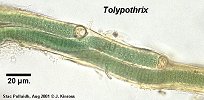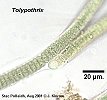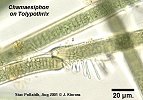FILAMENTOUS ALGAL SPECIES COMMON IN ACID AND SOFT WATERS.
Descriptions of operational taxa found in field studies in Scotland.
(Loch Ard area of The Trossachs, Galloway, Islay,
Morar and Glenelg:
Kinross, 1985, 1991 and unpublished data)
LIST
Cyanobacteria: Oscillatoriaceae:
Oscillatoria
Phormidium
Tolypothrix
Tolypothrix epiphyte
Stigonema
Scytonema
Amphithrix
Cyanobacteria: Oscillatoriaceae
1 = 'Oscillatoria' 1µm diameter
Little detail of this species is discernible in field samples, but it may be Pseudanabaena sp., which has been found to grow in cultures as an often significant contaminant of other algae. It has been found to grow in experimental conditions of low pH (4.0) and high [Al] (200µgl-1 at pH 5.5). Motility has not been observed. In field samples this 'taxon' probably includes several species.
2-6 = Oscillatoria species
These are cyanophytes growing as long straight filaments, showing no branching or heterocyst formation. They may occur as dense mats, like Phormidium spp. but more frequently are found intermingled with other algae, more dispersed than Phormidium as their distinguishing feature is the possession of motility. This however is not always exhibited during examination so that a degree of uncertainty may exist between Oscillatoria and Phormidium in some cases.
West (1904) concluded that the genus Phormidium may serve as a receptacle for species which cannot be strictly referred to Lyngbya and Oscillatoria.
Varieties encountered have been somewhat arbitrarily divided into size groups as
2,
5 
 ,
,
8, 11 and
14µm. diameter. Variations in colour are also found but these have not been
taken into account as they may depend on light regime.
7-10 = Phormidium species
These filamentous cyanophytes are non-motile and possess a thin sheath (not always easily visible). They are usually found in almost unialgal dense mats, sometimes with a mixture of other species, especially Oscillatoria.
They have been divided into the size groups 3, 4-5, 8 and 13µm diameter, taking no account of colour, as this can vary within a mat due to the effects of self-shading.
11 = Tolypothrix
This is a filamentous cyanophyte, approximately 11µm. diameter within a dense sheath which becomes dark brown with age.


The alga exhibits false branching, with a heterocyst always being found at the point of origin of a single branch. Hormogonia may be formed, composed of a small number of cells separated from others within the sheath. Isolated portions of the filament may therefore be readily confused with species of Lyngbya , if the false branching is not seen. The cells may be turquoise in young filaments but tend to turn brown with age.
12 = Tolypothrix epiphyte = Chamaesiphon
This is a cyanophyte frequently encountered as an epiphyte onTolypothrix as a greyish filament approximately 3µm diameter and greyish in colour, with no sheath or cell differentiation visible. Occasionally it is found as an epiphyte on other algae also.

13 = Stigonema

This cyanophyte is composed of cells closely appressed into a multiseriate filament, with small branches emerging from it initially as small knobs or swellings. The colour is dark green, frequently appearing black to the naked eye. It is more frequently found in damp, aerial locations than actually under water and may form dense 'mossy' expanses beside waterfalls, etc.
14 = Scytonema

This is a sheathed filamentous cyanophyte similar to Tolypothrix but having a different form of false branching, two false branches emerging from the sheath at the same point. Again if this feature is not seen the sample may be ascribed to the wrong genus. This picture shows a rarer form of false branching in Scytonema where a single branch is formed, but without a heterocyst at its base (cf. Tolypothrix).

50 = Amphithrix (now reidentified as Homoeothrix)
This is a sheathed cyanophyte with a tapering trichome, usually occurring as a
clump of filaments attached at their broad ends.
There is no terminal heterocyst as is found
in Calothrix.
John Kinross

